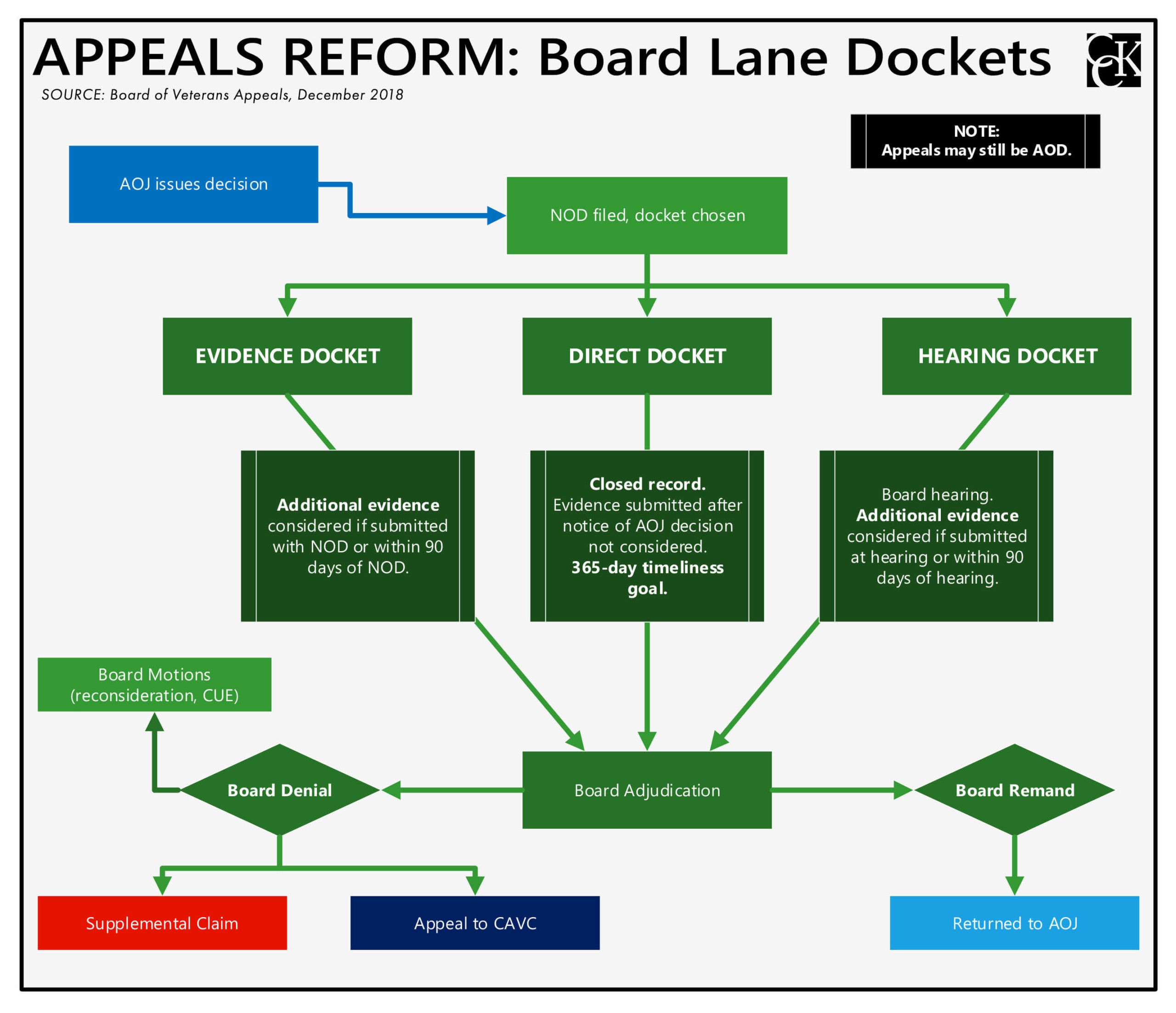What is the Process at the Board of Veterans’ Appeals Under the New VA Appeals System?

Appeals Reform was officially implemented on February 19, 2019. In this new system, veterans have one year to appeal an unfavorable decision from VA by choosing one of the following three review options, or lanes: the higher-level review lane, supplemental claim lane, and Notice of Disagreement lane (i.e. Appeal to the Board of Veterans’ Appeals).
Notice of Disagreement Lane (i.e. Appeal to the Board of Veterans’ Appeals)
In the Notice of Disagreement lane, veterans can appeal their claims directly to the Board of Veterans’ Appeals. Previously under the legacy appeals system (i.e. the old appeals system), veterans who received unfavorable decisions were required to overcome additional procedural hurdles when appealing to the Board, including the filing of an additional form and subsequent VA processing. However, the Notice of Disagreement lane under Appeals Reform removes the additional steps. By directly appealing to the Board, VA is hoping to prevent a backlog of claims and significantly decrease veterans’ amount of wait time when it comes to receiving decisions.
Importantly, veterans also have the option to choose the Notice of Disagreement lane after receiving unfavorable decisions in either the higher-level review lane or supplemental claim lane. Here, the one-year period to appeal remains the same. If veterans successfully appeal within that timeframe, they will preserve the effective date of their claim.
How to File a Notice of Disagreement Under Appeals Reform
When appealing directly to the Board under Appeals Reform, veterans will be required to submit a Notice of Disagreement form that is different from the one used in the legacy appeals system. On this form (VA Form 10182), veterans must identify the specific determination with which they disagree, and indicate which docket they are choosing. Specifically, veterans will be required to choose from an additional three lanes at the Board level:
- Direct review docket. For veterans who do not want to submit additional evidence to the Board, and do not want a hearing before a Veterans Law Judge. In this docket, the Board will look only at the evidence that was in the veteran’s file when the appealed decision was issued. VA has a 365-day goal for processing decisions in this docket, as it is anticipated to be the fastest lane.
- Hearing docket. For veterans who want to have a hearing before a Veterans Law Judge. The only hearing options available to veterans under Appeals Reform will be a videoconference hearing and a hearing at the Board in Washington, D.C. Travel board hearings, held by Veterans Law Judges at local Regional Offices, will only be available to veterans in the Legacy appeals system. Additional evidence can be submitted up to 90 days from when the hearing is held.
- Evidence docket. For veterans who want to submit additional evidence but do not want a hearing. Veterans can submit additional evidence to the Board along with their Notice of Disagreement and within 90 days following submission of the Notice of Disagreement.
When the Board receives an unclear or deficient Notice of Disagreement, the Board will notify the veteran and request clarification. The veteran must respond with the requested clarification within one year from the Agency of Original Jurisdiction decision, or 60 days after the date of the Board’s clarification request, whichever is later. If the veteran does not provide a timely response, his or her previous statement will not be considered an NOD.
Decisions from the Board: What Comes Next?
There are a few different outcomes depending on what type of decision a veteran receives from the Board. If a veteran receives a grant from the Board, it must be implemented by the Agency of Original Jurisdiction (i.e. local Regional Office or the Appeals Management Office). If the Veteran receives a denial from the Board, he or she has one of two options to appeal:
- Submit a supplemental claim. A veteran can file a supplemental claim with new and relevant evidence within one year of the date of the decision. If the claimant does so, his or her effective date will be preserved.
- Appeal to the CAVC. A veteran can appeal a Board denial to the Court of Appeals for Veterans Claims within 120 days of the date of the decision. If the veteran receives a further denial from the CAVC, he or she can again submit a supplemental claim within one year or appeal to the Federal Circuit within 60 days of the judgment. Here, the effective date following a CAVC denial would also be preserved.
Under Appeals Reform, VA’s duty to assist will not apply to the Board. As such, the Board will no longer be obligated to remand decisions for the purpose of developing additional evidence for the Veteran’s claim. However, if the Board finds that the Regional Office made a duty to assist error, it can remand the case and instruct the Regional Office to fix that error. Importantly, the duty to assist error must be pre-decisional, meaning it occurred prior to the Agency of Original Jurisdiction adjudication on appeal. in other words, the only evidence that can be looked at for duty to assist errors in the new system has to already be in the file prior to the initial decision.
About the Author
Share this Post

